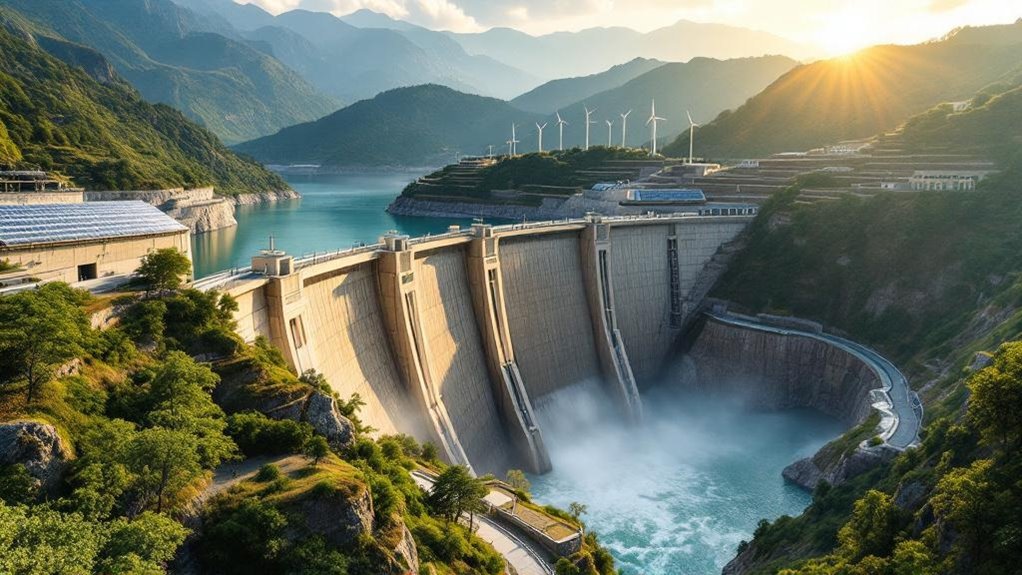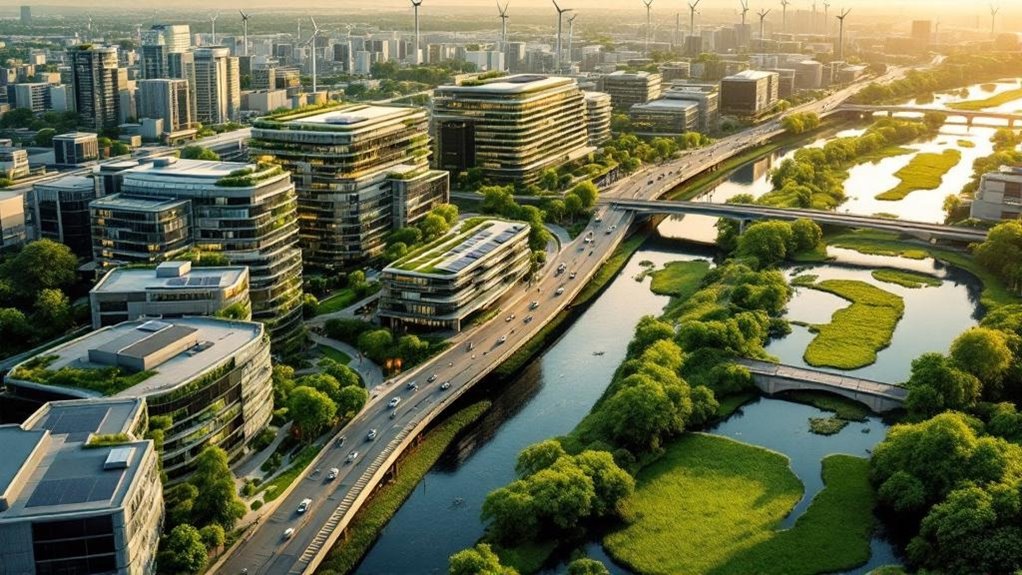Climate-resilient infrastructure investments yield compelling returns of $4-$10.50 for every dollar spent while safeguarding essential services against intensifying environmental threats. Strategic planning incorporates thorough risk assessments, advanced computational modeling, and smart monitoring systems to enhance structural durability and operational continuity. With standardized performance metrics and proven case studies demonstrating 27% average returns over 10 years, this emerging sector offers significant opportunities for investors seeking both financial and societal impact through systematic adaptation approaches.
Understanding Climate-Resilient Infrastructure Fundamentals

As climate change continues to pose unprecedented challenges to global infrastructure systems, understanding the fundamentals of climate-resilient infrastructure has become paramount for governments, developers, and stakeholders worldwide.
Climate-resilient infrastructure encompasses systems specifically engineered to withstand evolving climate impacts while maintaining essential services through climate adaptation strategies and sustainable construction practices. These infrastructure systems integrate thorough risk assessments and climate projections into their planning, design, and operational frameworks. Effective implementation requires risk-informed policy decisions to guide both public and private sector investments in resilient infrastructure development. A comprehensive hazard selection process helps identify and evaluate specific climate threats that could impact infrastructure systems.
The foundational elements of climate-resilient infrastructure include:
- Adaptive design principles enabling flexibility under various climate scenarios
- Integration of durable, environmentally conscious materials
- Implementation of smart monitoring systems
- Incorporation of redundancy measures for critical systems
- Utilization of nature-based solutions that enhance resilience while supporting ecosystem services
Assessing Risk and Vulnerability in Infrastructure Projects
While climate-resilient infrastructure development requires substantial investment and planning, conducting thorough risk and vulnerability assessments represents a critical first step in safeguarding infrastructure assets against climate-related threats. Effective monitoring requires local historical data to establish baseline vulnerabilities and inform adaptation strategies.
Organizations implementing the Physical Climate Risk Assessment Methodology (PCRAM) integrate extensive risk assessment protocols with vulnerability mapping techniques to evaluate exposure across multiple climate hazards. The methodology’s expert assessment team provides comprehensive analysis of climate impacts on infrastructure systems.
PCRAM enables comprehensive analysis of climate vulnerabilities through integrated assessment protocols, helping organizations map and evaluate multi-hazard exposure risks.
- Advanced spatial modeling tools analyze infrastructure vulnerabilities under various climate scenarios, identifying critical weak points.
- Multi-disciplinary data integration combines meteorological forecasts, asset inventories, and socioeconomic factors to generate detailed risk profiles.
- Systemic resilience metrics evaluate interconnected infrastructure sectors, highlighting potential cascade effects requiring targeted intervention.
This systematic approach aligns with evolving regulatory frameworks, including TCFD requirements, while enabling organizations to quantify and address climate risks effectively through evidence-based adaptation strategies.
Financial Benefits and Return on Investment Analysis

The compelling financial case for climate-resilient infrastructure investments rests on their exceptional return metrics, with every dollar invested generating $4-$10.50 in quantifiable benefits through avoided losses and development gains.
Analysis of 320 major resilience projects demonstrates an impressive 27% average rate of return over 10 years, while also revealing significant uncaptured value since only 8% of assessments fully monetize all resilience dividends.
These demonstrated returns, combined with reduced exposure to catastrophic losses, create attractive opportunities for public-private partnerships to help meet the annual $6.9 trillion investment needed for sustainable infrastructure development by 2030. Studies consistently show that investing in preparedness yields $13 in savings for every dollar spent on disaster mitigation and cleanup costs.
Despite record climate adaptation funding of $63 billion in 2021/22, significant challenges remain in directing private capital toward developing nations’ climate resilience projects.
Long-Term Cost Savings
Making strategic investments in climate-resilient infrastructure demonstrates compelling financial returns despite marginally higher upfront costs of approximately 3% compared to traditional infrastructure development.
Thorough cost benefit analysis reveals that every dollar invested yields between $4-$7 in future economic benefits, while investment strategies focused on resilience generate substantial long-term savings through reduced maintenance and operational expenses. The BRICS nations will require 44% of the US$94 trillion needed for infrastructure development through 2040, highlighting the massive scale of investment opportunities. Concessional funding mechanisms are increasingly being deployed to accelerate climate-resilient infrastructure projects in vulnerable regions.
Key long-term financial advantages include:
- Extended infrastructure lifespans with 4.4% higher retained value through 2050
- Decreased emergency repair frequencies and associated costs across asset portfolios
- Minimized post-disaster reconstruction expenditures and insurance claims
These demonstrated returns underscore the fiscal prudence of climate-resilient infrastructure investments, particularly when considering the World Bank’s validation of consistent 4:1 benefit-cost ratios and enhanced service continuity across critical systems.
Risk-Adjusted Investment Returns
Compelling evidence from global market analyses demonstrates that climate-resilient infrastructure investments consistently outperform conventional assets, delivering 20% higher cumulative returns in net-zero scenarios and 10% higher returns under limited climate action pathways. Investment strategies focused on climate adaptation yield substantial risk-adjusted returns while providing enhanced protection against both physical and changeover risks. With the need for USD 6.9 trillion in annual sustainable infrastructure investments by 2030, institutional investors are increasingly recognizing the financial advantages of climate-resilient assets. Green bond financing has emerged as a key mechanism for mobilizing private capital toward climate-resilient infrastructure projects.
| Performance Metric | Conventional Infrastructure | Climate-Resilient Infrastructure |
|---|---|---|
| Benefit-Cost Ratio | 1:1 | 4:1 |
| Insurance Costs | Higher Premiums | Reduced Premiums |
| Asset Value Retention | Vulnerable to Climate Shocks | Enhanced Stability |
The integration of resilience features during planning and refurbishment phases maximizes long-term performance while considerably reducing service interruption risks, with benefit-cost ratios averaging 4:1 over asset lifecycles.
Public-Private Partnership Opportunities
Building upon established evidence of superior returns in climate-resilient assets, public-private partnerships (PPPs) emerge as powerful vehicles for maximizing both financial and resilience outcomes in infrastructure development.
Through strategic public private collaboration and innovative funding mechanisms, PPPs enable governments to leverage private sector expertise while optimizing risk allocation and financial returns. Given the increasing vulnerability of Latin American and Caribbean nations to climate-related disasters, systematic risk assessment and mitigation strategies are essential components of successful PPP projects.
Key financial advantages of PPP structures include:
- Mobilization of substantial private capital, enabling simultaneous development of multiple infrastructure projects while reducing public fiscal pressure.
- Enhanced lifecycle cost efficiency through performance-based contracts and improved maintenance protocols.
- Access to diverse funding sources, including international climate funds and blended finance options, resulting in reduced upfront costs and accelerated project implementation.
The complementary strengths of public and private sectors create a synergistic framework that promotes sustainable, climate-resilient infrastructure development while ensuring attractive returns on investment.
Key Components of Successful Infrastructure Planning

Successful infrastructure planning requires five essential components that work in concert to create climate-resilient systems capable of withstanding future environmental challenges.
Through extensive risk assessments, robust design principles, flexible integration, systematic monitoring, and adaptive governance frameworks, organizations can develop infrastructure that serves communities effectively across multiple climate scenarios.
The process begins with thorough vulnerability mapping and risk assessment protocols, incorporating community engagement to identify critical assets requiring protection. Material selection focused on extreme weather durability is a crucial consideration during the initial planning phase.
This foundation enables the implementation of climate-adaptive designs featuring redundant systems and nature-based solutions.
Modular approaches and flexible systems architecture allow for scalable responses to emerging threats, while continuous monitoring through smart technologies guarantees peak performance.
Together, these elements create a cohesive framework that supports long-term infrastructure resilience and sustainable community development.
Strategic Funding Sources and Investment Models
While traditional infrastructure funding mechanisms have proven insufficient for meeting escalating climate resilience needs, a diverse ecosystem of strategic financing solutions has emerged to address the estimated $94 trillion global infrastructure investment gap through 2040.
Strategic funding partnerships between public and private sectors, coupled with innovative financial instruments, are revolutionizing how communities approach climate-resilient infrastructure development. Modern financing approaches must overcome behavioral inertia within traditional planning and engineering communities to drive transformative change.
- Multilateral development banks provide blended finance solutions incorporating grants, concessional loans, and technical assistance.
- Public-private partnerships facilitate community engagement through shared ownership models and risk-sharing mechanisms.
- Green bonds and sustainability-linked loans create dedicated funding streams while maintaining institutional investor requirements.
The integration of multiple funding sources, supported by regulatory frameworks and fiscal incentives, enables thorough infrastructure solutions that serve both immediate needs and long-term resilience objectives.
Implementing Nature-Based Solutions for Urban Resilience
Beyond traditional infrastructure investments, nature-based solutions represent a powerful approach to strengthening urban climate resilience through the strategic integration of natural systems and ecological processes.
Nature-based strategies encompass multiple interconnected elements, including urban forests that reduce temperatures by up to 2°C, wetland restoration projects that enhance water quality and flood management, and river renaturation initiatives that establish natural floodplains. These solutions are essential as they support sustainable development goals while protecting vulnerable urban populations.
Natural solutions interweave urban forests, restored wetlands, and renewed rivers to create resilient cities equipped for climate challenges.
Building-level adaptations such as green roofs and living walls complement these larger-scale interventions by reducing stormwater loads and supporting urban biodiversity. The implementation of vegetated slopes and bioswales further stabilizes vulnerable terrain while improving water infiltration.
Together, these integrated solutions create a thorough framework for climate adaptation while delivering multiple co-benefits, from enhanced ecosystem connectivity to improved community wellbeing.
Technical Design Standards and Engineering Specifications
Contemporary engineering specifications are undergoing substantial revisions to accommodate heightened structural load thresholds necessitated by climate change impacts, including intensified wind forces, increased hydrostatic pressures, and amplified thermal stresses.
Diverse stakeholder collaboration has become essential for developing and implementing these updated specifications across different infrastructure sectors. The American Society of Civil Engineers (ASCE) has established updated parameters for material performance requirements, mandating enhanced durability metrics and elevated resistance specifications for construction materials exposed to extreme weather conditions.
These modernized technical standards incorporate probabilistic risk assessments and adaptive design criteria, ensuring infrastructure components maintain operational integrity throughout their projected service life despite escalating environmental stressors.
Structural Load Thresholds
Every climate-resilient infrastructure project requires carefully calculated structural load thresholds that define the maximum forces and stresses a structure can safely withstand without compromising its integrity or functionality.
These thresholds must incorporate load adaptability measures to address evolving climate projections, ensuring infrastructure resilience against intensifying environmental pressures. Modern infrastructure designs must account for increased vehicle weights as electric vehicles continue replacing traditional combustion engine vehicles.
- Hydrostatic and hydrodynamic forces from increased flooding events require enhanced computational modeling to determine appropriate structural capacities.
- Temperature-induced material expansion and contraction patterns demand precise load distribution calculations across critical structural components.
- Wind load parameters must account for escalating storm intensities, particularly in coastal and high-risk zones.
Engineers and planners must regularly reassess these thresholds through continuous monitoring and data integration, utilizing advanced sensor networks and remote sensing technologies to validate design parameters against real-world conditions.
Material Performance Requirements
Technical design standards and engineering specifications for climate-resilient infrastructure establish rigorous material performance requirements that govern the selection, testing, and implementation of construction materials across diverse environmental conditions.
These requirements emphasize thorough durability testing against temperature extremes, humidity fluctuations, and chemical exposure. Incorporating probabilistic risk analysis helps determine optimal material specifications for varying climate scenarios.
Material selection protocols mandate resistance to UV radiation, precipitation, and freeze-thaw cycles, while emphasizing corrosion-resistant properties for flood-prone and coastal applications.
Standards specify the use of reinforced concrete, advanced composites, and specialized alloys that demonstrate superior performance under simulated climate stressors.
Performance verification involves lifecycle testing under controlled environmental conditions, with particular attention to degradation rates, structural integrity, and long-term stability.
Certification bodies require ongoing monitoring and documentation of material behavior to maintain sustained compliance with evolving climate resilience specifications.
Building Partnerships for Project Success
Since successful climate-resilient infrastructure projects require coordinated action across multiple sectors and stakeholders, building effective partnerships has emerged as a cornerstone of project implementation and long-term sustainability. The current financial constraints faced by governments make private sector participation increasingly vital for infrastructure development.
Effective stakeholder engagement and partnership dynamics create a foundation for sustainable infrastructure development through collaborative decision-making and shared responsibility.
Strong partnerships and engaged stakeholders drive sustainable infrastructure by fostering shared ownership and collaborative solutions to climate challenges.
- Public-Private Partnerships facilitate strategic risk allocation and mobilize private sector expertise while leveraging public sector resources.
- Multi-stakeholder platforms enable knowledge sharing between technical experts, local communities, and financing institutions.
- Collaborative monitoring frameworks establish accountability measures that track project performance and adaptation outcomes.
The integration of diverse partners, from local community groups to international financing institutions, strengthens project resilience and guarantees infrastructure investments deliver meaningful climate adaptation benefits while meeting community needs.
Performance Monitoring and Adaptive Management
Effective monitoring of climate-resilient infrastructure requires thorough performance metrics and real-time data collection systems to evaluate adaptation outcomes and identify vulnerabilities.
Standardized indicators, developed by organizations like WHO and UNICEF, enable consistent measurement across water, sanitation, and other critical infrastructure sectors while facilitating comparative analysis between projects. Current data shows that less than 30% of infrastructure entities conduct physical scenario evaluations for resilience assessment.
The integration of smart sensors and digital monitoring platforms enhances data accuracy and enables rapid response capabilities, with redundant systems ensuring continuous performance tracking even during extreme weather events.
Measuring Infrastructure Performance Metrics
Measuring infrastructure performance requires a sophisticated framework of metrics operating across multiple organizational levels to evaluate climate resilience and adaptive capacity. Performance indicators span input, output, and outcome measures, enabling thorough resilience assessment across physical assets, systems, and investment portfolios.
- Asset-level metrics track specific infrastructure components through quantifiable measures such as operational uptime during extreme weather events.
- System-wide indicators evaluate broader network resilience by monitoring service continuity, recovery times, and adaptation effectiveness. Infrastructure assets face a projected net value decline of 4.4% by 2050 due to climate-related degradation.
- Portfolio-level measurements assess investment outcomes through economic metrics, including avoided losses and lifecycle cost reductions.
The framework integrates location- and hazard-specific metrics to identify regional vulnerabilities while adhering to international standards like the Paris Agreement and MDB Assessment Framework.
This multi-tiered approach facilitates adaptive management through systematic monitoring and data-driven decision-making.
Real-Time Data Collection Systems
Real-time data collection systems represent the operational backbone of infrastructure performance monitoring, enabling continuous assessment and adaptive management through sophisticated technological architectures.
These systems leverage both agent-based and agentless approaches to gather extensive telemetry from diverse infrastructure components. SolarWinds and Datadog provide unified visibility across modern distributed environments for comprehensive monitoring capabilities.
The integration of automated sensor deployment across physical and virtual environments facilitates granular data capture at one-second intervals, ensuring rapid detection of performance anomalies.
Advanced telemetry analysis incorporates CPU metrics, memory usage, network bandwidth, and response times from multiple sources, including operating systems, databases, and cloud-based infrastructure.
This sophisticated monitoring framework supports dynamic resource allocation while enabling predictive maintenance through continuous data streams, ultimately enhancing the resilience and adaptability of infrastructure investments in response to climate-related challenges.
Global Best Practices and Success Stories
Leading examples from across the globe demonstrate how climate-resilient infrastructure investments can successfully mitigate environmental risks while delivering substantial socioeconomic benefits.
Nations and municipalities implementing extensive climate adaptation strategies have established frameworks that integrate infrastructure resilience across multiple sectors, yielding measurable improvements in community protection and economic stability. Recent advancements in digital technologies have revolutionized how communities prepare for and respond to climate-related challenges.
- The Netherlands’ “Room for the River” program exemplifies innovative flood management through integrated river engineering and urban planning, creating multi-functional spaces that protect communities while enhancing ecological value.
- India’s ICRG initiative showcases successful community-based infrastructure development, combining traditional knowledge with modern techniques.
- Rotterdam’s Climate Adaptation Strategy demonstrates urban resilience through thorough planning, incorporating green infrastructure and adaptive water management systems.
These case studies highlight the effectiveness of collaborative, multi-stakeholder approaches in building climate-resilient infrastructure.
Frequently Asked Questions
How Can Small Communities Afford Climate-Resilient Infrastructure Without Substantial Funding Sources?
Small communities can leverage innovative financing mechanisms and community partnerships to fund climate-resilient infrastructure despite limited resources.
Through participation in state-level loan programs offering sub-1% interest rates, collaboration with nonprofit organizations, and utilization of green bonds, municipalities can access capital while minimizing costs.
Additionally, prioritizing small-scale adaptation projects with high impact-to-cost ratios and pursuing technical assistance for grant applications enables communities to maximize available funding opportunities.
What Certifications Do Engineers Need to Design Climate-Resilient Infrastructure Projects?
Engineers designing climate-resilient infrastructure typically require specialized certification requirements and engineering credentials beyond traditional professional engineering licenses.
Key certifications include the Climate-Resilient Infrastructure Officer (CRIO) certification, Certified Climate Resilience Specialist (CCRS), and the Envision Sustainability Professional (ENV SP) credential.
Additionally, university-affiliated graduate certificates in resilient infrastructure from institutions like UMass Dartmouth and NJIT provide thorough training in climate adaptation and sustainable design principles.
How Long Does It Typically Take to Complete Major Climate-Resilient Infrastructure?
Major climate-resilient infrastructure projects typically require 6-12 years for completion across all project timelines and construction phases.
The process encompasses 2-5 years for planning and approvals, 1-2 years for detailed design, 3-8 years for construction execution, and 6-18 months for commissioning.
These extended durations reflect the complexity of incorporating climate adaptation features, stakeholder engagement requirements, and specialized technical validations throughout the project lifecycle.
Can Existing Infrastructure Be Retrofitted for Climate Resilience Cost-Effectively?
Evidence demonstrates that retrofitting existing infrastructure for climate resilience is highly cost-effective when employing appropriate retrofitting techniques and thorough cost analysis.
Studies from institutions like FM Global indicate that every $1 invested in resilience retrofits can avoid $2-105 in losses, depending on the hazard type.
The National Institute of Building Sciences confirms substantial returns across various retrofit strategies, with seismic upgrades yielding $12 and hurricane protection returning $8 for each dollar invested.
Which Insurance Providers Specifically Cover Climate-Resilient Infrastructure Projects?
Key insurance providers offering climate coverage and infrastructure underwriting for resilient projects include:
- BlackRock, serving as a primary asset manager for climate-resilient infrastructure initiatives
- Insurance Development Forum (IDF) member companies providing specialized coverage through the CILRIF program
- Domestic and international insurers participating in pilot programs in Makati, Durban, and Freetown
These providers typically offer long-term contracts exceeding 10 years, with premiums linked to municipalities’ implementation of specific resilience measures.
Conclusion
Climate-resilient infrastructure investment represents a critical imperative for sustainable development in an era of increasing environmental volatility. Through strategic planning, robust risk assessment protocols, and innovative financing mechanisms, organizations can develop infrastructure systems that withstand climate pressures while delivering optimal returns. Implementation of thorough monitoring frameworks, coupled with adaptive management strategies, guarantees these investments maintain their resilience and effectiveness across their operational lifespans.
References
- https://www.adaptation-undp.org/climate-resilient-infrastructure
- https://news.climate.columbia.edu/2024/07/22/the-case-for-climate-resilient-infrastructure/
- https://infrastructure-pathways.org/key-concepts/
- https://stateofgreen.com/en/news/12-examples-of-climate-resilient-city-solutions/
- https://www.numberanalytics.com/blog/climate-resilient-infrastructure-guide
- https://www.undrr.org/publication/principles-resilient-infrastructure
- https://globalplatform.undrr.org/2022/sites/default/files/2022-05/UNDRR 2022 Principles for Resilient Infrastructure.pdf
- https://www.mottmac.com/en-us/insights/topics/pcram-the-industry-methodology-for-climate-resilient-infrastructure-investment/
- https://www.cdri.world/g20-drrwg-case-study/37
- https://global.infrastructureresilience.org
